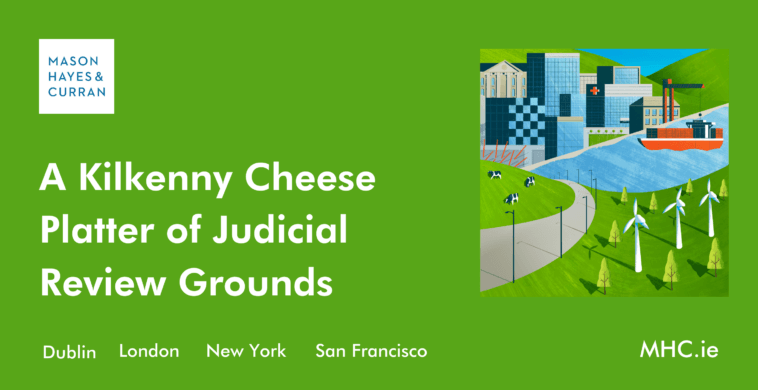
An Taisce - The National trust for Ireland v An Bord Pleanala & ors, [2021] IEHC 254, [2021] IEHC 422, [2021] IESCDET 109]
This case concerned a joint venture between Glanbia Ireland and Royal A-Ware. The companies sought planning permission to construct a cheese manufacturing plant in Co. Kilkenny. Kilkenny County Council (the Council) had granted planning permission for the development on 14 November 2019. The applicant, An Taisce, appealed the granting of this permission to An Bord Pleanála (ABP), who granted planning permission on 30 June 2020 following a favourable inspector’s report. One of the arguments made by An Taisce was that the milk required for the cheese would need to come from 4,500 farms. The indirect effects from these dairy farms may adversely impact Ireland’s ability to meet its climate and environmental policy targets.
Environmental Impact Assessment
The Court found that the planning permission was not invalid over ABP’s failure to conduct an assessment of the upstream impact of milk production. The Inspector considered there would be an indirect impact from the milk production but that this would be mitigated by production efficiency and Glanbia’s sustainability programme. The Inspector also considered these emissions are already accounted for and regulated through the National Climate Action Plan as part of dairy sector emissions.
The Court agreed with ABP and held that the effects of milk production are too remote and are sufficiently removed from the development to be assessed in site-specific terms. Therefore, it is not to be considered part of the development for the purposes of an Environmental Impact Assessment (EIA) or Appropriate Assessment (AA). The CJEU had already given guidance on the key distinction, which is that between “programmatic” measures and the “procedures for grant of an environmental permit”.
Policy decisions
Mr Justice Humphreys noted that the applicant’s real grievance was with public policy. He considered that whilst policy decisions are not beyond the scope of judicial consideration, “they aren't a basis for challenging a particular decision under the planning code”. The applicant was trying to use the latter process to indirectly challenge the former which is not permissible as a collateral attack. For these reasons, An Taisce’s case was dismissed.
The Board’s appropriate assessment
One of the other applicant’s grounds was that An Bord Pleanala’s appropriate assessment was flawed. An Appropriate Assessment (AA) must be carried out before planning permission is granted, to determine whether there are likely to be any adverse effects on the integrity of any European Sites from the proposed development. The Board’s assessment must contain complete, precise and definitive findings and conclusions and may not have lacunae or gaps. The applicant alleged that the Board’s appropriate assessment contained gaps.
The applicant alleged that firstly, the inspector had erred in screening out certain interests in the AA, particularly Atlantic salt meadows, and secondly, the Board had not adequately considered the impact of treated effluent. Although these points were not raised with the Board before it made its decision, the Judge assumed the applicant still had standing to make them. The same judge had held in another case that if grounds and evidence are to be admitted in a legal challenge, they must have been put to the decision-maker before it made its decision, subject to limited exceptions (Reid v the Board (no 1) [2021] IEHC 230 – for further information on that case, please see case update 2 above). Broadly the rationale behind the general rule is that it would be otherwise unfair for the decision-maker.
The Judge held that the main consequence of not having pursued these issues in the planning process is that there was no scientific evidence put before the Board to contradict the Natura Impact Statement. This statement was prepared by the developer and relied upon by the Board in making its appropriate assessment. In relation to the treated effluent, the Judge didn’t agree with the Board and developer that this would be a matter for the Environmental Protection Agency. However, evidence on the Board’s assessment was not raised with the Board before it made its decision.
The High Court judgment on the application for leave to appeal
The Judge subsequently dismissed the applicant’s application for leave to appeal his High Court judgment to the Court of Appeal ([2021] IEHC 422). The Judge did not consider any of the grounds raised comprised a point of law of exceptional public importance on which leave to appeal should be granted to the Court of Appeal.
The Supreme Court determination of the leave to appeal judgment
The applicant applied for leave directly to the Supreme Court - what is known as a “leapfrog appeal”. The applicant contended that Mr Justice Humphreys required the applicant to put forward scientific evidence showing doubt in the decision-maker’s AA. The Board argued that the Mr Justice Humphreys in fact required the applicant to point to some aspect of the evidence before the decision-maker.
The Supreme Court in allowing the applicant’s application [2021] IESCDET 109] considered that: “there are, in the Court’s view, questions as to how evidence in that regard should be dealt with in a challenge brought to a consent granted” and “the Court does consider that bringing further clarity as to the proper approach to evidence or argument in relation to relevant scientific matters in judicial review proceedings of this type is a matter of general public importance which arises in these proceedings.”
Further Supreme Court judgment clarifying scope of the appeal
In a further judgment on 7 December 2021, Mr Justice Hogan clarified that the scope of the Supreme Court appeal will not be limited to the ground relating to the Habitats Directive. The applicant had filed submissions regarding whether the indirect effects from “the off-site milk production” were properly assessed in the Board’s EIA (see case update 8). In addition, the Judge allowed within the scope of the appeal an argument by the applicant: “whether the Board was precluded from granting permission in circumstances where this will lead to an increased discharge of pollutants into the River Suir and where it is said that that waterbody has not achieved what is termed “good’ status for the purposes of Article 28 of the Surface Water Regulations”. However, the Board or the notice party would be allowed to argue that the ground should not be determined, as it was not sufficiently raised or pleaded to the High Court.
Although these issues were not noted in the initial Supreme Court determination, the Judge clarified that, following a fuller oral hearing in which the parties have been given an opportunity to address the Court, the Court may clarify or modify the earlier determination. That approach is consistent with the general administration of justice and fairness to the parties.
Conclusion
This case shows that indirect effects from the source of materials or resources that are transported to, and used, in a separate manufacturing process, are normally considered too remote to be assessed as part of that second process in an EIA. Those effects need to be considered as part of any assessment for their production in the first place, and more widely as part of government policy. In this regard, there is a difference between programmatic or policy decisions and individual planning or environmental decisions for permits or permissions. The latter cannot be a basis for judicial intervention for the former.
Government policy can be challenged in the Courts in exceptional circumstances such as violations of statute. However, the fact that there are different views on a matter does not mean that governmental policy is incorrect. Questions of distributive justice, which means how common benefits and burdens are distributed in society, is a matter for elected representatives. Standalone court cases are too focused on individual facts to be an appropriate means of deciding policy.
That said, the Supreme Court will consider whether off-site milk production should have been included in the EIA or whether it was too remote. In addition, the Supreme Court will consider a question raised for appropriate assessments. There is a well-established principle that all scientific doubt must have been removed when determining if there are any adverse effects on the integrity of a European protected site. However, there is less clarity on the evidence required to show that scientific doubt to a decision-maker and the Supreme Court will provide its judgment on this issue.
The Supreme Court may also consider an issue about the Board’s decision in the context of the Water Framework Directive. However this issue may not be determined by the Supreme Court if the Board or notice party can show it was not sufficiently raised or pleaded in the High Court.
An inadequate AA or EIA are commonly raised grounds in judicial review applications and many planning permissions have been quashed as result. Commentary from the Supreme Court on these grounds, and if allowed, the Water Framework Directive ground, will be helpful for decision-makers and developers. However, this may cause delays in the interim for judicial review challenges where these grounds have been raised.
For more information contact a member of our Planning & Environment Team.
The content of this article is provided for information purposes only and does not constitute legal or other advice.
Share this:





